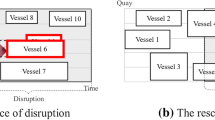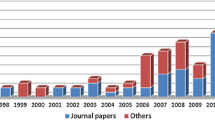Abstract
The berth allocation and quay crane assignment problem (BACAP) is a complex port operation planning problem susceptible to uncertainties, such as vessel arrival time fluctuation to its estimated time of arrival and maritime markets. For promoting reliability and sustainability of container terminals, this paper addresses the optimization of BACAP under the uncertain vessels’ arrival times and fluctuation of loading and unloading volumes. We propose a proactive BACAP strategy considering minimum recovery cost under uncertainty using a reactive strategy. A stochastic programming model is formulated to minimize the basic cost in the baseline schedule, and the recovery cost in real uncertain scenarios. A two-stage meta-heuristic framework based on GA is developed for solving this problem. Numerical experiments and scenario analysis are conducted to validate the effectiveness of the proposed model and the proposed solution approaches.






Similar content being viewed by others
References
Bierwirth, C., & Meisel, F. (2015). A follow-up survey of berth allocation and quay crane scheduling problems in container terminals. European Journal of Operational Research, 244(3), 675–689.
Carlo, H. J., Vis, I. F. A., & Roodbergen, K. J. (2015). Seaside operations in container terminals: Literature overview, trends, and research directions. Flexible Services and Manufacturing Journal, 27(2–3), 224–262.
Chen, G., & Jiang, L. P. (2016). Managing customer arrivals with time windows: A case of truck arrivals at a congested container terminal. Annals of Operations Research, 244(2), 349–365.
Drewry Shipping Consultants. (2020). Global container terminal operators annual review and forecast 2019 London, UK.
Dulebenets, M. A. (2019). Minimizing the total liner shipping route service costs via application of an efficient collaborative agreement. IEEE Transactions on Intelligent Transportation Intelligent Transportation Systems, 20(1), 123–136.
Han, X., Lu, Z., & Xi, L. (2010). A proactive approach for simultaneous berth and quay crane scheduling problem with stochastic arrival and handling time. European Journal of Operational Research, 207(3), 1327–1340.
He, J. (2016). Berth allocation and quay crane assignment in a container terminal for the trade-off between time-saving and energy-saving. Advanced Engineering Informatics, 30(3), 390–405.
He, J., & Tan, C. (2018). Modelling a resilient yard template under storage demand fluctuations in a container terminal. Engineering Optimization, 51(9), 1547–1566.
He, J., Tan, C., Yan, W., Huang, W., Liu, M., & Yu, H. (2020). Two-stage stochastic programming model for generating container yard template under uncertainty and traffic congestion. Advanced Engineering Informatics, 43, 101032.
He, J., Tan, C., & Zhang, Y. (2019). Yard crane scheduling problem in a container terminal considering risk caused by uncertainty. Advanced Engineering Informatics, 39, 14–24.
Hendriks, M., Laumanns, M., Lefeber, E., & Udding, J. T. (2010). Robust cyclic berth planning of container vessels. OR Spectrum, 32(3), 501–517.
Imai, A., Chen, H. C., Nishimura, E., & Papadimitriouc, S. (2008). The simultaneous berth and quay crane allocation problem. Transportation Research Part E: Logistics and Transportation Review, 44(5), 900–920.
Iris, C., & Lam, J. S. L. (2019). Recoverable robustness in weekly berth and quay crane planning. Transportation Research Part B: Methodological, 122, 365–389.
Iris, Ç., Pacino, D., Ropke, S., & Larsen, A. (2015). Integrated berth allocation and quay crane assignment problem: Set partitioning models and computational results. Transportation Research Part E: Logistics and Transportation Review Rev., 81, 75–97.
Kasm, O. A., Diabat, A., & Cheng, T. C. E. (2020). The integrated berth allocation, quay crane assignment and scheduling problem: Mathematical formulations and a case study. Annals of Operations Research, 291(1–2), 435–461.
Li, M. Z., Jin, J. G., & Lu, C. X. (2015). Real-time disruption recovery for integrated berth allocation and crane assignment in container terminals. Transportation Research Record Journal of the Transportation Research Board, 2479, 49–59.
Lim, A. (1998). The berth planning problem. Operations Research Letters, 22, 105–110.
Meisel, F., & Bierwirth, C. (2009). Heuristics for the integration of crane productivity in the berth allocation problem. Transportation Research Part E: Logistics and Transportation Review, 45(1), 196–209.
Meisel, F., & Bierwirth, C. (2013). A framework for integrated berth allocation and crane operations planning in seaport container terminals. Transportation Science, 47(2), 131–147.
Oğuz, C., Zinder, Y., Do, V. H., Janiakc, A., & Lichtensteinc, M. (2004). Hybrid flow-shop scheduling problems with multiprocessor task systems. European Journal of Operational Research, 52(1), 115–131.
Rahman, H. F., Sarker, R., & Essam, D. (2015). A real-time order acceptance and scheduling approach for permutation flow shop problems. European Journal of Operational Research, 247(2), 488–503.
Rodriguez-Molins, M., Ingolotti, L., Barber, F., Salido, M. A., Sierra, M. R., & Puente, J. (2014). A genetic algorithm for robust berth allocation and quay crane assignment. Progress in Artificial Intelligence, 2(4), 177–192.
Shang, X. T., Cao, J. X., & Ren, J. (2016). A robust optimization approach to the integrated berth allocation and quay crane assignment problem. Transportation Research Part E: Logistics and Transportation Review, 94, 44–65.
Tan, C., He, J., & Wang, Y. (2017). Storage yard management based on flexible yard template in container terminal. Advanced Engineering Informatics, 34, 101–113.
Tan, C., He, J., & Yu, H. (2019). Mathematical modeling of yard template regeneration for multiple container terminals. Advanced Engineering Informatics, 40, 58–68.
Umang, N., Bierlaire, M., & Erera, A. L. (2017). Real-time management of berth allocation with stochastic arrival and handling times. Journal of Scheduling, 20(1), 67–83.
Wang, Z., & Guo, C. (2018). Minimizing the risk of seaport operations efficiency reduction affected by vessel arrival delay. Industrial Management & Data Systems, 118(7), 1498–1509.
Wang, K., Zhen, L., Wang, S., & Laporte, G. (2018). Column generation for the integrated berth allocation, quay crane assignment, and yard assignment problem. Transportation Science, 52(4), 812–834.
Xiang, X., Liu, C., & Miao, L. (2017). A bi-objective robust model for berth allocation scheduling under uncertainty. Transportation Research Part E: Logistics and Transportation Review, 106, 294–319.
Xiang, X., Liu, C., & Miao, L. (2018). Reactive strategy for discrete berth allocation and quay crane assignment problems under uncertainty. Computers & Industrial Engineering, 126, 196–216.
Zeng, Q., Yang, Z., & Hu, X. (2011). Disruption recovery model for berth and quay crane scheduling in container terminals. Engineering Optimization, 43(9), 967–983.
Zhen, L., Lee, L., & Chew, E. (2011). A decision model for berth allocation under uncertainty. European Journal of Operational Research, 212(1), 54–68.
Zhou, P. F., & Kang, H. G. (2008). Study on berth and quay-crane allocation under stochastic environments in container terminal. Systems Engineering - Theory & Practice, 28(1), 161–169.
Acknowledgements
This work is sponsored by the National Natural Science Foundation of China (Grant Numbers 72072112, 72002125, 71602114); Shanghai Rising-Star Program (Grant Number 19QA1404200) and Shanghai Sailing Program (Grant Number 19YF1418800).
Author information
Authors and Affiliations
Corresponding author
Additional information
Publisher's Note
Springer Nature remains neutral with regard to jurisdictional claims in published maps and institutional affiliations.
Appendix: The neighborhood generation approach
Appendix: The neighborhood generation approach
The neighborhood generation approach put forwarded in this paper is similar to the one proposed by Zhen et al. (2011), however, the two following aspects in this paper are different from the latter approach. Firstly, it cannot change their sequence if the vessels arrived before the frozen period point in scenario ω. Secondly, the cost function for evacuating the value of vessels in baseline schedule So under uncertain scenario ω is updated by \( c_{i}^{1 + } s_{i}^{{\Delta { + }}} (\omega ){ + }c_{i}^{1 - } s_{i}^{\Delta - } (\omega ){ + }c_{i}^{2 + } e_{i}^{{\Delta { + }}} (\omega ){ + }c_{i}^{2 - } e_{i}^{\Delta - } (\omega ) + c_{i}^{3 + } y_{i}^{\Delta + } (\omega ) + c_{i}^{3 - } y_{i}^{\Delta - } (\omega ) \). The detailed process is shown as follow.
-
Step 1: Evaluate the adjusting cost of baseline schedule under uncertain scenario ω (\( RCost(v) = c_{i}^{1 + } s_{i}^{{\Delta { + }}} (\omega ){ + }c_{i}^{1 - } s_{i}^{\Delta - } (\omega ){ + }c_{i}^{2 + } e_{i}^{{\Delta { + }}} (\omega ){ + }c_{i}^{2 - } e_{i}^{\Delta - } (\omega ) + c_{i}^{3 + } y_{i}^{\Delta + } (\omega ) + c_{i}^{3 - } y_{i}^{\Delta - } (\omega ) \)), if their estimated arrival time ETAi is behind the frozen period point λ(ω);
-
Step 2: Calculate the gap of recovery cost between consecutive vessels \( Gap_{i} = Rcost(V_{i + 1} ) - Rcost(V_{i} ) \), where Vi is the ith vessel in baseline schedule So;
-
Step 3: Select the vessel Vi with maximum recovery cost gap (Gapi) to exchange the sequence with their consecutive vessel Vi+1, and generate the first neighborhood (vessel berthing sequence);
-
Step 4: Successively exchange the sequence of vessel Vi with 2th, 3th, …, Rth recovery cost gaps with their consecutive vessel Vi+1, and generate the new neighborhoods. If the neighborhood generate has already existed, exchange the vessel Vi with (R + 1)th recovery cost gap with their consecutive vessel Vi+1 until obtain the Rth neighborhood.
Rights and permissions
About this article
Cite this article
Tan, C., He, J. Integrated proactive and reactive strategies for sustainable berth allocation and quay crane assignment under uncertainty. Ann Oper Res (2021). https://doi.org/10.1007/s10479-020-03891-3
Accepted:
Published:
DOI: https://doi.org/10.1007/s10479-020-03891-3




